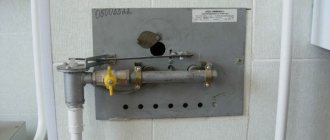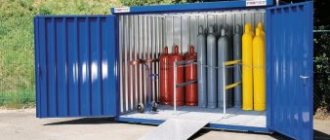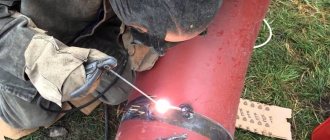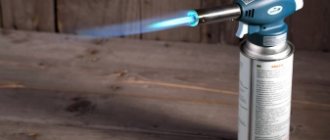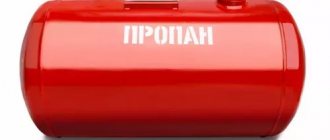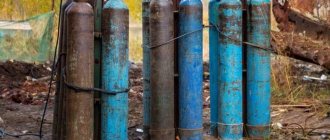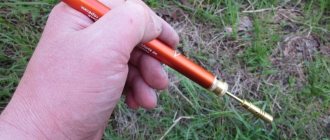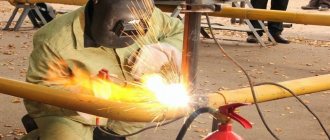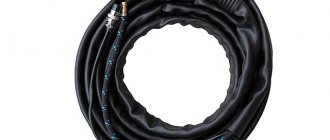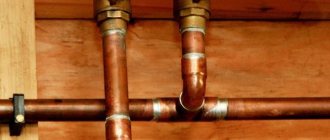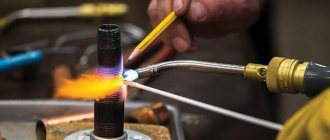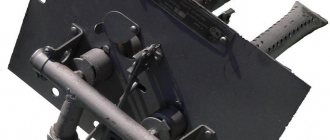| Place | Name | Characteristics in the rating |
| The best gas cutters for metal |
| 1 | Krass Р3П-300 | The best choice |
| 2 | REDIUS Р2А-01М | Lightweight design |
| 3 | DONMET RK Vognik 182 | Universal plasma torch |
| 4 | KEDR R3P-05 1390036 | Long design |
| 5 | Svarog RZ 62-3F 1C005-0012 | Best Lever Blow Cutter |
| Best Handheld Metal Cutters |
| 1 | Pathfinder-GTP-S05 | Best manual cutter |
| 2 | Campingaz Chalugaz profile | Most comfortable handheld design |
| 3 | Kovea KT-2008 | Convenient cutter for small jobs |
| 4 | Pathfinder GTP-R03 | Compact tool |
| 5 | Kovea KT-2911 Long Canon | Hand torch with extended nozzle |
There are many ways to cut metal, but the most effective, simple, and, oddly enough, safe is the gas method. The essence of the technology is based on the chemical interaction of flammable gas, in most cases propane, with oxygen. As a result of this synthesis, a directed flame is formed with a high temperature in the center, which reaches the melting point of steel.
A more modern method is plasma cutting. The technology is similar, only an electric arc acts as the jet activator. A plasma cutter is capable of creating a thinner cut, but if in the case of propane it is enough to acquire only two gas cylinders (with propane and oxygen), then you will need a special device - a plasma torch.
When choosing a cutter, you should first of all pay attention to its ergonomics and convenience. Typically, the cutting process takes many hours, and some places are very difficult to reach. The design of the cutter is selected individually, depending on the tasks assigned. We also look at the safety of the tool, but if we talk about our rating, which includes the 10 best cutters, then this parameter is present in all models, regardless of their price category.
The best gas cutters for metal
A gas cutter consists of several modules: a holder, a valve system, tubes and a nozzle. Each model has its own characteristics. For example, the nozzle should be equipped with kickback protection, and the handle should fit comfortably in the hand and not slip out. When choosing, special attention is paid to the valve system, which bears the main load during operation. The location of the valves also matters in terms of convenience, and in some models the purge valve is replaced with a lever. Such tools are also presented in our rating.
Types of portable cutters
A portable gas cutter is a fairly simple design. The principle of operation is the creation of a directed jet of flame by mixing oxygen and flammable gas. The cutter is based on a cylinder and a burner that is attached to it. According to the type of fuel supply, portable cutters are divided into:
- Injection
- Injectorless.
The main advantage of injection-type cutters is their high combustion temperature. The main advantage of injection-free cutters is their high mobility and simplicity of design.
Important: Cutters can also be divided according to the type of fuel used. There is no narrow list here. There are devices running on acetylene, kerosene, and gasoline. But butane is most often used. For portable cutters, ready-made disposable cylinders with a collet clamp are sold.
Injection portable cutters
An injection-type burner requires the presence of two cylinders - oxygen and a cylinder with flammable gas. Cylinders have a capacity from 2 to 5 liters. The mechanism for starting the injector is as follows:
- Combustible gas is supplied under high pressure through a twin tube
- Oxygen is supplied in the same way
- The gas mixed in a special chamber, without losing its initial speed, escapes from the nozzle
- Using an external source, or through a built-in piezoelectric element, a spark is supplied
The mobility of the injection burner is not high. The design of two cylinders is quite cumbersome. However, these burners are designed to be carried by one person.
Important: To choose a durable mini injection cutter, pay attention to the material of the outer mouthpiece. According to GOST requirements, the nozzle is made of chromium bronze or copper. Some manufacturers do not comply with the requirements and make nozzles from brass. Such nozzles have a shorter service life.
Injectorless portable burners
A gas collet is one of the cheapest tools for gas welding. It consists of a gas cylinder with a capacity of up to 0.5 liters, to which a burner with a nozzle is attached through a collet connection. The advantages of the device are:
- Highest mobility. The entire structure weighs no more than 700 grams. No special containers or bags are needed for carrying.
- Versatility. In addition to their direct functions, such burners are used for heating car locks, as a blowtorch, etc.
- Ease of use. There is no need to fine-tune the fuel supply to the nozzle. To get started, just click the button with the piezoelectric element.
There are also quite a lot of disadvantages. The main ones include:
- The flame goes out easily. The injector-less design does not involve active oxygen supply. The strong flow of compressed propane creates an unstable jet of flame that is easy to knock down.
- High operating costs. Consumption is about 200 ml. gas per hour of work. Those. even the largest cylinder will be discharged after 2.5 hours of operation.
- Relatively low combustion temperature. Although mini-cutters heat up to 1300 degrees, they cannot compete with their injection counterparts. The gas exit velocity, as well as the efficiency of the mini-cutter, is lower.
Mini-burners, even similar in appearance, differ significantly both in flame quality and design solutions. For example, a mini gas cutter from KOVEA Fire-Z Torch is manufactured on a collet connector and has an operating temperature of up to 1500 degrees. And the HecatonTorch KT-2610 burner from the same company produces a flame of up to 2500 degrees.
Additionally, the Fire-Z Torch uses a collet connection for disposable cylinders, while the HecatonTorch uses a US thread. If you need a portable blowtorch with advanced functionality for the garage, it is better to purchase the first option. And if you consider the torch as a professional tool, it makes sense to overpay 1000 rubles and buy HecatonTorch with a US connection
Do-it-yourself cutting torch
A compact and simple, but quite effective gas cutter is offered. It easily melts and cuts copper wires and heats up sheet metal in a short time (seconds). Using this example, you can understand the principle of building a more powerful homemade gadget and, if you really want to, create it. To make it you will need:
- two large medical IVs;
- needle for inflating balls (volleyball/soccer);
- aquarium compressor. Can be replaced with a plastic two-liter bottle;
- cylinder for refilling gas lighters with propane;
- copper wire;
- soldering iron complete (stand with trays, solder, flux, etc.);
- thermal gun (thermal glue);
- removable nipple for car camera;
- thin file or fine-grained emery stone.
The principle of operation of the device, after reading the article, will be intuitively clear from the figure.
Do-it-yourself cutting torch. East. https://www.lifetweaks.ru/dlya-avtolyubitelya/gazovyj-mini-rezak-svoimi-rukami/.
We make a hole (incision) in a large needle and pass a curved medical needle through it (we grind off its sharp tip). We wrap this place for sealing with copper wire and seal it (does it already resemble a gas burner?). All that remains is to provide air supply from the compressor and propane from the cylinder. The limiter clamps on the dropper tubes will regulate the torch flame. We suggest you think through the rest yourself and you will get a gas cutter with your own hands.
DIY mini autogen
Carrying out gas cutting or gas welding work requires not only careful adherence to safety precautions, but also specialized equipment: an autogen, also commonly called a gas torch or a gas cutter, will help perform work of varying complexity quickly, efficiently, and professionally. In the article you will learn about the operating principle and classification of this tool.
Gas cutting using autogen is a very common procedure, which is based on the property of metal to heat up under the influence of high temperatures, which makes it easy to cut it in the desired direction. The main areas of application of autogens are installation and construction work - both professional (industrial) and household; To perform welding, in addition to the autogen, a filler rod is required.
Autogen. How to cut metal with gas?
Carrying out gas cutting or gas welding work requires not only careful adherence to safety precautions, but also specialized equipment: an autogen, also commonly called a gas torch or a gas cutter, will help perform work of varying complexity quickly, efficiently, and professionally.
In the article you will learn about the operating principle and classification of this tool. Gas cutting using autogen is a very common procedure, which is based on the property of metal to heat up under the influence of high temperatures, which makes it easy to cut it in the desired direction. The main areas of application of autogens are installation and construction work - both professional (industrial) and household; To perform welding, in addition to the autogen, a filler rod is required.
How does autogen work?
Technical progress has somewhat changed the design of the autogen, which initially included a gas burner, an oxygen cylinder, an acetylene generator and connecting hoses; the control and reduction of oxygen pressure was carried out by a reducer with a pressure gauge.
Over time, for greater convenience, the acetylene generator with automatic maintenance of gas pressure was replaced by an acetylene cylinder, but the name “autogen”, probably derived from the combination of the words “automatic generator”, has taken root and is widely used by craftsmen.
The operating principle of the autogen is based on the property of metal to burn in chemically pure oxygen, and therefore there are two key points that are necessary when operating the cutter: a direct cutting jet of pure oxygen and a heating gas (usually acetylene or propane).
The design of a modern autogen is quite simple and represents the interaction of two basic functional parts:
- a tip for supplying a jet of cutting flame, having internal and external mouthpieces united by a nozzle nozzle;
- a barrel with a chamber connecting gas and oxygen and valves located on the body for connecting hoses to oxygen and gas units and adjusting the gas supply volume, speed and pressure of the oxygen jet.
The reduced pressure (the required level of oxygen discharge) is formed due to the injection barrel, where oxygen is partially supplied and from where the jet exits into the mouthpiece channel at high speed.
Another direction of oxygen movement will be the main channel of the internal mouthpiece, which forms the cutting jet.
The mixing section of the autogen is necessary to combine the gas component (acetylene or propane) and oxygen - in the future, this mixture will become a heating flame supplied between the internal and external mouthpiece of the tip. The tip is attached to the barrel using an ordinary union nut.
Structurally, the models of various cutters from different manufacturers may have some nuances, but in general the configurations and operating principle are quite traditional - changes in the design mostly bring ease of use and greater safety. Modern gas cutting or welding is already unthinkable without these tools.
Autogen for cutting/welding metal: classification
The entire range of autogens available in specialized stores is divided according to various criteria:
- by purpose: special (for a special kind of specific work) and universal, suitable for most gas cutting and welding work. Universal torches equipped with an injector are simple and easy to use, are lightweight, and are capable of cutting workpieces with a thickness of 3...300 mm in all directions.
The type of combustible mixture forms its own classification:
- in very low-cost oxygen autogens, the formation of a burning jet occurs with oxygen;
- Kerosene cutters operate on kerosene vapor and are usually used for cutting carbon steel workpieces up to 200 mm thick. The rather complex design of such an autogen makes it practically inapplicable for small household work - kerosene autogens are usually used in the coal and mining industries (due to the high explosion hazard, propane/acetylene autogens are usually not used in these industries) ;
- considered the most reliable and safe, efficient and productive propane autogens are used for cutting ferrous and non-ferrous metals - most often for cast iron batteries, pipes, etc.;
- acetylene autogens will be the best choice when processing workpieces or elements of considerable thickness - the properties of the acetylene combustible mixture allow you to create a flame of maximum temperature: even a compact tool in its design will be convenient and effective when working with massive parts and workpieces;
- according to the design and method of mixing the oxygen and combustible components, autogens are divided into injection and non-injector;
- according to the method of metal cutting: autogenous separation, spear, surface or oxygen-flux processing (for high-chromium, high-alloy steels).
Whatever autogen is chosen by the master, it is important that it is efficient and productive, and corresponds to the nature of the work and the properties of the elements intended for cutting or welding.
Mini cutter
A manual autogen is usually small in size - an even smaller version of it is called a mini-cutter. The main characteristics of such a tool include a confident flame pressure and a gas tank of sufficient volume, allowing the device to be used even in windy weather.
During operation, it should be taken into account that the mini - autogen is not designed for long-term continuous use: high temperatures can melt the tool body without the possibility of repair or replacement of damaged parts.
However, the time of use is limited by the volume of the gas tank: the autogen lighter must be refilled periodically, and for this a regular collet cylinder is useful.
Unlike convenient and efficient modern manual models (including a rather expensive autogen with piezo ignition, activated by pressing just one button), mini-cutters are characterized by low cost, and therefore are available to literally everyone, not only professional, but also home craftsmen.
The main areas of use of such an autogen are household work that requires cutting or welding of metal elements: repair of air conditioners, cars, bicycles, refrigerators, etc. The disadvantages of the tool include the short length of the cutting flame, which somewhat limits the work of such a device with certain types of metals.
Operation of the autogen and features of its use
The sequence of working with autogen can be represented by the following steps:
- Studying the structure and operating principles of a particular model, checking the correct location of the autogen parts, connecting the hoses for supplying flammable gas and oxygen.
- Special rubber seals are treated with glycerin or a lubricant provided for this purpose. It is important that the connections of the threaded type autogen components are sealed - this minimizes the risk of gas leakage during operation of the gas autogen.
- By supplying a dosed stream of oxygen, a vacuum of gas is formed in the channels of the instrument.
- Opening the gas valve will ignite the combustible mixture, which heats the metal to a temperature sufficient for cutting.
- Valves on the oxygen and gas supply channels regulate the size of the cutting flame, the intensity and temperature of combustion in accordance with the materials of the workpiece, its thickness, etc.
- At the moment the metal, heated to the required temperature, is absolutely ready for cutting, a stream of cutting oxygen is supplied, and the part is cut properly.
- Extinguishing the burner flame is carried out in the reverse order - first the gas channel valve is tightened, then the oxygen channel. If the tip becomes very hot (which is quite possible during long-term work), cooling is carried out with cold water.
During operation, switching on and off the device, as well as its storage, fire safety rules should be followed and strictly observed.
Autogen maintenance
Proper use and after-use maintenance will not only make the work safe, but will also significantly extend the service life of the autogen.
A technological feature of autogen is the rapid wear of the nozzle and mouthpieces - internal and external, which are directly exposed to pure oxygen and gas.
The solution to this problem will be regular cleaning of the nozzle channels with a soft copper rod of suitable length, and with experience and work skill, competent and accurate selection of the match between the thickness of the metal workpiece and the pressure of the supplied cutting mixture will not allow the use of the autogen, as they say, for wear.
Autogen prices vary over a wide cost range: it is formed depending on the design and type of tool, its characteristics, functionality, purpose (domestic or industrial work), and country. High-quality and reliable, with a solid warranty period, models of gas cutters produced in South Korea or America are among the most expensive.
Setting up a cutting torch
Before starting work, you should assemble the equipment and check its functionality in accordance with the “Operating Instructions”. Only after this can the metal processing process begin.
If you do not have access to the “Instructions”, then proceed in the following sequence. Before assembly, it is necessary to carry out an external inspection of the components and parts:
- check the condition of all rubber gaskets . If there are the slightest defects, they must be replaced;
- carefully inspect the oxygen valve . The slightest traces of oil or fat are not allowed on its surface - their presence can lead to an explosion;
- carefully inspect the fittings . The flammable gas connection must have a check valve. Defects on the fittings should be carefully corrected with a “velvet” file. If this is not done, then the rubber gasket of the gearbox will “poison” with all the ensuing consequences.
After inspection, gearboxes should be installed:
- blue – for an oxygen cylinder;
- red - for a propane tank.
If the cutter has injection, you should check its functionality:
- the check is carried out before connecting the flammable gas hose;
- the oxygen hose is connected to the corresponding fitting;
- open the oxygen reducer valve;
- open the oxygen and flammable gas valves on the cutter;
- Place your finger on the flammable gas fitting. If everything works, then it should be “sucked in”. In this case there will be no backlash.
Next, a propane hose is installed and gas is connected. The ratio of propane and oxygen is set to 1:10. For example, if the oxygen pressure is 5 atm, then the propane pressure should be set to 0.5 atm.
It is necessary to open and stop the gas supply in the following sequence:
- open each oxygen and flammable gas valves by 0.5 turns (the sequence cannot be changed). Set the mixture on fire;
- bring the torch to the metal and add oxygen until a “crown” appears;
- upon completion of work: the supply of flammable gas is stopped first, then oxygen (the sequence cannot be changed).
Ultra-portable torches for small jobs
The class of ultra-portable torches is useful where small welding and soldering are needed without the ability to connect electrical appliances. Such burners are powered by liquid gas for refilling lighters and are divided into 2 groups:
- With a cylinder for a collet connector and with a high pressure hose
- With built-in fuel tank
A portable gas cutter with a hose is a compact version of a mini-torch for a collet connector. A special feature is that the burner is mounted on a hose. Thanks to this, the cylinder can be placed in a backpack behind your back, and a light nozzle the size of a standard soldering iron will remain in your hands. An example is KT-2202 from KOVEA. The weight of the device without a cylinder is 140 grams, and the maximum temperature, as in larger devices, is up to 1300 degrees.
Since small work does not require large fuel costs, manufacturers often equip burners with a built-in fuel tank. The weight of an unfilled device usually does not exceed 50 grams, and the volume of the fuel tank is up to 100 ml.
Manual compact burners with a built-in fuel tank are used in the following areas:
- Soldering of radio components. They can be used as a soldering iron or a soldering iron. To do this, a nozzle with a tinned tip is attached to the outlet hole. Such burners have high heat output. Therefore, they are suitable for working with large parts.
- Work in conditions of lack of electricity. A compact pocket gas cutter is useful at a construction site if the wiring in the house under construction is not installed and it is impossible to use an electric soldering iron. Also, they are popular when installing cable networks, because... eliminate the need for the engineer to route power to the roof.
- Working in the cold . Using the torch as a soldering iron is convenient when working at low temperatures, because... the burner quickly heats the space around the soldering area, which greatly facilitates the process.
There are quite a lot of cheap hand torches from China in online stores. Because The design is simple, many people do not dare to overpay for famous brands. If you want to buy a Chinese burner, it is better to do it in a store where you can immediately check its operation. A common defect in cheap burners is gas leakage at the connecting points. Even if we do not take into account the obvious danger of such products, the constant loss of butane will not allow storing the burner charged for a long time.
